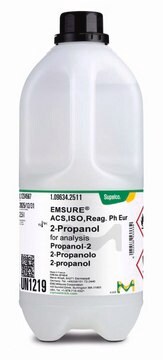1.00974
Ethanol (denatured)
≥99.5% (GC), reagent grade, for extraction, for analytical purposes, EMSURE®
Synonyme(s) :
Éthanol dénaturé, Éthanol
About This Item
Produits recommandés
product name
Éthanol, denatured with about 1% methyl ethyl ketone for analysis EMSURE®
Qualité
denatured
for analytical purposes
for extraction
reagent grade
Niveau de qualité
Pression de vapeur
59 hPa ( 20 °C)
Gamme de produits
EMSURE®
Pureté
≥99.5% (GC)
Forme
liquid
Température d'inflammation spontanée
425 °C (ethanol)
Puissance
6200 mg/kg LD50, oral (Rat)
Limite d'explosivité
1.3-15 % (v/v) ethanol)
Impuretés
≤0.00001% Ba (Barium)
≤0.00005% Al (Aluminium)
≤0.00005% B (Boron)
≤0.001% Free acid (as acetic acid)
≤0.1% Water
0.8-1.3% Ethylmethylketone (GC)
Résidus d'évap.
≤0.001%
pH
7 (20 °C)
Pf
-114.5 °C (ethanol)
Température de transition
flash point 12 °C (ethanol)
Densité
0.79 g/cm3 at 20 °C
Traces de cations
Ca: ≤0.00005%
Cd: ≤0.000005%
Co: ≤0.000002%
Cr: ≤0.000002%
Cu: ≤0.000002%
Fe: ≤0.00001%
K: ≤0.0001%
Mg: ≤0.00001%
Mn: ≤0.000002%
Ni: ≤0.000002%
Pb: ≤0.00001%
Sn: ≤0.00001%
Zn: ≤0.00001%
Application(s)
environmental
food and beverages
industrial qc
pharmaceutical
sample preparation
Format
neat
Température de stockage
2-30°C
Chaîne SMILES
CCO
InChI
1S/C2H6O/c1-2-3/h3H,2H2,1H3
Clé InChI
LFQSCWFLJHTTHZ-UHFFFAOYSA-N
Vous recherchez des produits similaires ? Visite Guide de comparaison des produits
Description générale
Application
- Separation of lignin derivatives from hemp fiber using supercritical CO2, ethanol, and water at different temperatures.: This study demonstrates a method for separating lignin derivatives from hemp fibers using a combination of supercritical CO2, ethanol, and water, highlighting the role of ethanol in enhancing the efficiency of the extraction process, which is crucial for the sustainable production of bio-based materials (Zhang et al., 2024).
- Elimination of Toxic Solvents from Analytical Methods in Food Analysis: Caffeine Determination in Tea as an Example.: This article discusses the development of analytical methods that eliminate the use of toxic solvents in food analysis, specifically highlighting the replacement of harmful solvents with safer alternatives like ethanol, promoting safer and more environmentally friendly practices (Kalisz et al., 2024).
- High throughput microfluidics-based synthesis of PEGylated liposomes for precise size control and efficient drug encapsulation.: This study explores the use of ethanol in the high-throughput synthesis of PEGylated liposomes, utilizing microfluidics technology to ensure precise size control and efficient drug encapsulation, which are critical for targeted drug delivery systems (Akar et al., 2024).
- A novel method for quantitative determination of multiple substances using Raman spectroscopy combined with CWT.: This research introduces a novel approach for the quantitative determination of substances where ethanol is used as a solvent to enhance the spectroscopic analysis, proving crucial for accurate and efficient analytical measurements (Yang et al., 2024).
- Quality criteria, chemical composition, and antimicrobial activity of the essential oil of Mentha suaveolens Ehrh.: This study involves the extraction of essential oils where ethanol is employed as a solvent to extract active compounds effectively, focusing on the antimicrobial properties and chemical composition of the oils (Afrokh et al., 2024).
Remarque sur l'analyse
Identité (IR) : conforme
Acide libre (exprimé en acide acétique) : ≤ 0,001 %
Méthyléthylcétone (GC) : 0,8 - 1,3 %
Substances facilement carbonisables : conforme
Résidus d′évaporation : ≤ 0,001 %
Eau : ≤ 0,1 %
Al (aluminium) : ≤ 0,00005 %
B (bore) : ≤ 0,00005 %
Ba (baryum) : ≤ 0,00001 %
Ca (calcium) : ≤ 0,00005 %
Cd (cadmium) : ≤ 0,000005 %
Co (cobalt) : ≤ 0,000002 %
Cr (chrome) : ≤ 0,000002 %
Cu (cuivre) : ≤ 0,000002 %
Fe (fer) : ≤ 0,00001 %
K (potassium) : ≤ 0,0001 %
Mg (magnésium) : ≤ 0,00001 %
Mn (manganèse) : ≤ 0,000002 %
Ni (nickel) : ≤ 0,000002 %
Pb (plomb) : ≤ 0,00001 %
Sn (étain) : ≤ 0,00001 %
Zn (zinc) : ≤ 0,00001 %
Informations légales
greener alternative product
Mention d'avertissement
Danger
Mentions de danger
Conseils de prudence
Classification des risques
Eye Irrit. 2 - Flam. Liq. 2
Code de la classe de stockage
3 - Flammable liquids
Classe de danger pour l'eau (WGK)
WGK 1
Point d'éclair (°F)
53.6 °F - (ethanol)
Point d'éclair (°C)
12 °C - (ethanol)
Certificats d'analyse (COA)
Recherchez un Certificats d'analyse (COA) en saisissant le numéro de lot du produit. Les numéros de lot figurent sur l'étiquette du produit après les mots "Lot" ou "Batch".
Déjà en possession de ce produit ?
Retrouvez la documentation relative aux produits que vous avez récemment achetés dans la Bibliothèque de documents.
Les clients ont également consulté
Contenu apparenté
Our ergonomic 1 L HDPE bottle for acids, bases, and solvents provide an alternative to glass chemical bottles for lab safety in pouring & handling of hazardous chemicals in the laboratory.
Notre équipe de scientifiques dispose d'une expérience dans tous les secteurs de la recherche, notamment en sciences de la vie, science des matériaux, synthèse chimique, chromatographie, analyse et dans de nombreux autres domaines..
Contacter notre Service technique




